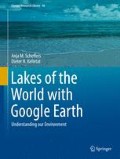Abstract
In geological time scales, lakes are young features on the Earth’s surface (merely decades up to many thousands of years). The existence of lakes often depends on climatic conditions that can guarantee the amount of surface water will exceed evaporation in the same region. In contrast, wetlands are able to develop in very shallow relief (and even on plains) where incoming water becomes stagnant. One important reason to the present day existence of high numbers of swamps or bogs or other kinds of wetlands, is a lake may pass through this phase of being a wetland through its early development and may pass it again when loosing water. The principal difference between lakes (with open water) and wetlands is the presence of plants (Hydrophytes), particularly along the wide fringes of the shores, but also as floating islands breaking loose from the fringe, or growing from the shallow bottom to the surface. Wetlands can quickly change appearance where open water may be totally covered by floating plants and water of some depth may still exist below, or growing from the bottom, a carpet of reed and grass with no visible water volumes. If decomposition is slow as a result of unsuitable climate conditions (e.g. high precipitation and low temperatures), wet vegetation mats may also grow from flat low-lying areas forming domed surfaces demonstrated in the dominant moss bogs (raised bogs) of circum-polar latitudes. Marshes or mangrove woodlands describe plants in wetlands along ocean shores (algae, grass, herbs, even trees) that have adapted to survive the salt- water conditions including tidal currents and some wave action.
Access this chapter
Tax calculation will be finalised at checkout
Purchases are for personal use only
References
Allanson BR, Hart RC, O’Keeffe JH et al (1990) Inland waters of Southern Africa. An ecological perspective. Kluwer, Boston
Beadle LC (1981) The inland waters of tropical Africa. An introduction to tropical limnology, 2nd edn. Longman, London
Bedford BL (1996) The need to define hydrologic equivalence at the landscape scale for freshwater wetland mitigation. Ecol Appl 6(1):57–68
Bridgewater P (2008) A new context for the Ramsar Convention: wetlands in a changing world. Reciel 17(1):100–106
Evangelisti D, D’Amelia D, Di Lallo G et al (2013) Relationship between salinity and bacterioplankton in three relic coastal ponds (Macchiatonda Wetland, Italy). J Water Resour Prot 5(9):859–866
Fraser LH, Keddy PA (eds) (2005) The World’s largest wetlands: ecology and conservation. Cambridge University Press, Cambridge UK
Glaser PH (1992) Raised bogs in eastern North America: regional controls for species richness and floristic assemblages. J Ecol 80:535–554
Hails AJ (1996) Wetlands, biodiversity and the Ramsar Convention: the role of the Convention on wetlands conservation and wise use of biodiversity. Ramsar Convention Bureau, Gland
Hart TM, Davis SE (2011) Wetland development in a previously mined landscape of East Texas, USA. Wetl Ecol Manag 19:317–329
Hughes FMR (ed) (2003) The Flooded Forest: guidance for policy makers and river managers in Europe on the restoration of floodplain forests. Department of Geography, University of Cambridge, Cambridge, UK
Johnson WC, Millett BV, Gilmanov T et al (2005) Vulnerability of northern prairie wetlands to climate Change. Bio Sci 10:863–872
Jordan TE, Andrews MP, Szuch RP et al (2007) Comparing functional assessments of wetlands to measurements of soil characteristics and nitrogen processing. Wetlands 27(3):479–497
Keddy PA (2010) Wetland ecology: principles and conservation, 2nd edn. Cambridge University Press, New York
Lehner B, Döll P (2004) Development and validation of a global database of lakes, reservoirs and wetlands. J Hydrol 296:1–22
MacDonald GM, Beilmann BW, Kremenetski KV et al (2006) Rapid early development of circum-arctic peatlands and atmospheric CH4 and CO2 variations. Science 314(5797):285–288
MacKenzie WH, Moran JR (2004) Wetlands of British Columbia: a guide to identification, Land management handbook 52. Ministry of Forests, Government Publication Services, Victoria
Maltby E, Barker T (eds) (2009) The wetlands handbook. Wiley-Blackwell, Oxford
Mitsch WJ, Gosselink JG (2007) Wetlands, 4th edn. John Wiley and Sons, New York
Mitsch WJ, Gosselink JG, Zhang L et al (2009) Wetland ecosystems. John Wiley and Sons, New York
Nelson ML, Rhoades CC, Dwire KA (2011) Influences of bedrock geology on water chemistry of slope wetlands and headwaters streams in the southern Rocky Mountains. Wetlands 31:251–261
Roulet NT (2000) Peatlands, carbon storage, greenhouse gases, and the Kyoto protocol: prospects and significance for Canada. Wetlands 20(4):605–615
Smith MJ, Schreiber ESG, Kohout M et al (2007) Wetlands as landscape units: spatial patterns in salinity and water chemistry. Wetl Ecol Manag 15(2):95–103
Solomeshch AI (2005) The west Siberian lowland. In: Fraser LH, Keddy PA (eds) The World’s largest wetlands: ecology and conservation. Cambridge University Press, Cambridge UK, pp 11–62
Author information
Authors and Affiliations
Rights and permissions
Copyright information
© 2016 Springer International Publishing Switzerland
About this chapter
Cite this chapter
Scheffers, A.M., Kelletat, D.H. (2016). Swamps, Bogs and Other Wetlands. In: Lakes of the World with Google Earth. Coastal Research Library, vol 16. Springer, Cham. https://doi.org/10.1007/978-3-319-29617-3_3
Download citation
DOI: https://doi.org/10.1007/978-3-319-29617-3_3
Published:
Publisher Name: Springer, Cham
Print ISBN: 978-3-319-29615-9
Online ISBN: 978-3-319-29617-3
eBook Packages: Earth and Environmental ScienceEarth and Environmental Science (R0)

